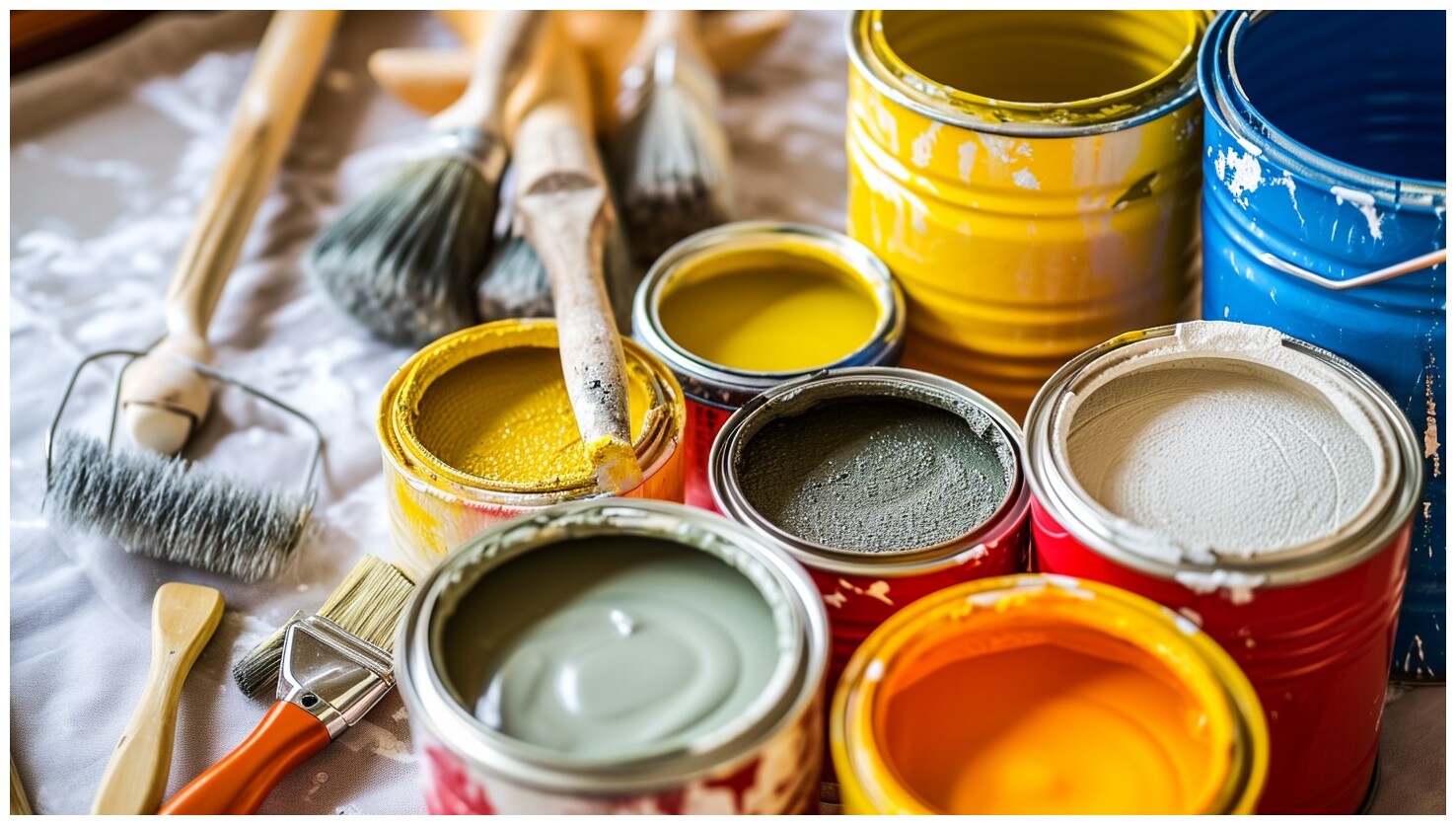Water-Based vs Solvent-Based Paints: A Comprehensive Comparison in 2024

When it comes to choosing the right paint for your project, one of the first decisions you’ll face is whether to go with water-based or solvent-based paint. This choice will not only affect the appearance and finish of the surface but also play a role in health, environmental impact, and durability. In 2024, with advances in paint technology and increased awareness around eco-friendly products, understanding the differences between these two types of paints is crucial for making the right decision. At Lanny Builders Limited, we do professional painting that resonates with your inner vision of your home. We don’t just be creative we follow your inner desire and blend it with out creativity to actually give you the physical vision of your inner desire. Contact us for professional painting works.
Without further ado, let’s dive into the world of water-based and solvent-based paints, exploring their characteristics, advantages, and ideal applications.
What are Water-Based Paints?
Water-based paints, sometimes referred to as latex or acrylic paints, use water as their primary solvent. As a result, they are low in volatile organic compounds (VOCs), making them an environmentally friendly and healthier option. Water-based paints have improved significantly in recent years, with advanced formulations providing better coverage, durability, and faster drying times.
In 2024, water-based paints are the go-to choice for many interior and exterior applications due to their user-friendly nature and reduced environmental impact.
Key Advantages of Water-Based Paints
- Low VOCs and Eco-Friendly
One of the main reasons homeowners, contractors, and DIY enthusiasts opt for water-based paints is their low VOC content. VOCs are harmful chemicals that can release toxic fumes into the air, contributing to indoor air pollution and environmental damage. With stricter environmental regulations in 2024, more paint manufacturers are focusing on reducing VOC levels, making water-based paints the greener choice. - Fast Drying
Water-based paints dry quickly, typically within a few hours, making them ideal for projects that need to be completed in a shorter timeframe. This quick drying time is particularly advantageous for interior spaces where occupants want to avoid prolonged exposure to paint fumes. - Easy Cleanup
Since water is the primary solvent in these paints, cleaning up after a painting project is as simple as using soap and water. This reduces the need for harsh chemicals like turpentine or mineral spirits, which are required to clean up solvent-based paints. - Non-Yellowing
Water-based paints resist yellowing over time, making them ideal for surfaces like trim, ceilings, and doors that you want to maintain a bright, clean look for years. - Versatility and Flexibility
Advances in paint technology have made water-based paints suitable for a variety of surfaces, including wood, metal, and masonry. They are highly flexible and less likely to crack or peel over time, especially in areas with high humidity or fluctuating temperatures.
Drawbacks of Water-Based Paints
- Less Durability for High-Wear Areas
Although water-based paints are more durable than ever, they may still fall short in high-traffic or high-wear areas like floors or industrial settings compared to solvent-based paints. For heavy-duty projects that require a tough, long-lasting finish, solvent-based paints might be a better option. - Adhesion on Glossy Surfaces
Water-based paints can struggle to adhere to very smooth or glossy surfaces without proper surface preparation. A good primer is often necessary when painting over these surfaces to ensure long-lasting results.

What are Solvent-Based Paints?
Solvent-based paints, often referred to as oil-based paints, use organic solvents such as turpentine or mineral spirits to dissolve the pigments and binders. These paints have been popular for decades, especially for high-durability applications and projects requiring a smooth, glossy finish. However, the environmental impact of solvent-based paints has raised concerns, particularly because they tend to contain higher levels of VOCs.
In 2024, solvent-based paints are still widely used in specific applications, but their environmental impact has led many to seek out low-VOC alternatives or hybrid formulations.
Key Advantages of Solvent-Based Paints
- Superior Durability
Solvent-based paints are known for their durability and resistance to wear and tear. They form a hard, robust finish that makes them ideal for surfaces exposed to high traffic or harsh environmental conditions. This makes solvent-based paints popular for industrial applications, metal surfaces, and exterior woodwork. - High Gloss and Smooth Finish
When it comes to achieving a smooth, glossy finish, solvent-based paints often outperform water-based options. They dry to a harder surface, offering a professional, high-gloss look that is perfect for furniture, doors, and other wood surfaces. - Strong Adhesion
Solvent-based paints adhere exceptionally well to a wide variety of surfaces, including metal, wood, and even previously painted glossy surfaces. This makes them suitable for projects where strong adhesion is critical, such as painting metal railings or trim. - Resistance to Humidity and Moisture
Solvent-based paints are highly resistant to moisture and humidity, making them an excellent choice for outdoor applications and areas prone to dampness, such as bathrooms or kitchens.
Drawbacks of Solvent-Based Paints
- High VOC Content
The most significant disadvantage of solvent-based paints is their high VOC content. These chemicals not only have a strong odor but also contribute to air pollution and can be harmful to human health. With increased regulations on VOC levels in 2024, solvent-based paints are being scrutinized more than ever for their environmental impact. - Longer Drying Time
Solvent-based paints take significantly longer to dry compared to water-based alternatives. Depending on the application, drying times can range from several hours to days, which can prolong a project and increase exposure to fumes. - Difficult Cleanup
Cleaning brushes, rollers, and other tools after using solvent-based paint requires the use of harsh chemicals like mineral spirits or paint thinner, making cleanup more complicated and less eco-friendly. - Yellowing Over Time
Unlike water-based paints, solvent-based paints are prone to yellowing, particularly in areas with little natural light. This can affect the long-term appearance of surfaces, especially in light colors like white or cream.

Choosing Between Water-Based and Solvent-Based Paints in 2024
In 2024, the choice between water-based and solvent-based paints largely depends on the specific needs of your project. For indoor applications or areas where low VOC content and fast drying times are important, water-based paints are the clear winner. They provide an environmentally friendly, user-friendly option that still delivers impressive durability and finish quality.
However, for exterior surfaces, industrial projects, or areas requiring extreme durability and gloss, solvent-based paints may still be the best option. Despite their environmental drawbacks, solvent-based paints offer superior resistance to weathering, abrasion, and moisture, making them indispensable in certain high-stress environments.
Hybrid and Low-VOC Solvent-Based Options
As environmental consciousness grows, many paint manufacturers in 2024 are working on low-VOC solvent-based paints and hybrid paints that combine the benefits of both water-based and solvent-based formulations. These products are designed to offer the durability and finish of solvent-based paints while minimizing VOC emissions and environmental harm.
Finale
In the debate between water-based vs. solvent-based paints, there is no one-size-fits-all answer. Each type of paint has its strengths and weaknesses, depending on the project’s demands. With advancements in paint technology and stricter environmental regulations, water-based paints are becoming the default choice for many applications, offering eco-friendliness and performance. However, solvent-based paints still hold their place in heavy-duty and high-gloss projects where durability and adhesion are critical.
As you plan your next painting project, consider the surface, location, and desired finish, while also keeping an eye on environmental impact and health safety. Choosing the right paint can make all the difference in both the performance and sustainability of your work.